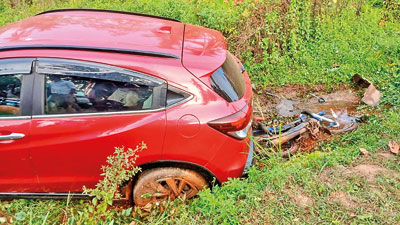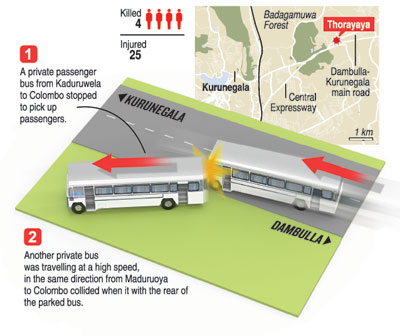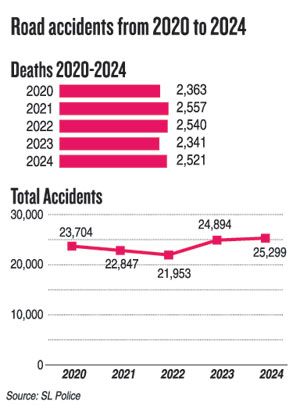News
Increasing road traffic accidents: A sinister pattern emerges
View(s):By Dilushi Wijesinghe
Road traffic accidents in Sri Lanka are increasing at an alarming rate, posing a significant threat to drivers, passengers, and pedestrians alike. Studies have identified several key factors contributing to this crisis, including driver fatigue, reckless driving, poor infrastructure, and inadequate law enforcement.
On Thursday (February 14) alone, the media highlighted five road traffic accidents. One incident involved NPP MP Muhammad Faizal, whose vehicle—driven by a relative—tragically ran over a motorcyclist. Investigations revealed that the driver had fallen asleep. Three more lives were lost in separate road accidents the same day.

The accident on Thursday involving the vehicle of an MP. Pic by Hiran Priyankara
Highlighting growing concerns, particularly the dangers posed by driver fatigue and negligence, a 2021 study on risks for road traffic accidents found that most accidents are caused by human factors such as age, alcohol consumption, sleep difficulties, fatigue, stress, and lack of safety measures.
Conducted by Prof. J.M.K.B. Jayasekara, and Kotelawala Defence University’s Department of Nursing and Midwifery senior lecturer Piyumi Weerawardhana, the study analysed 360 drivers admitted to accident wards in teaching hospitals in Kandy and Kurunegala.
Findings revealed that 46.4% of the drivers had at least eight hours of sleep the night before the accident, while 23.6% had slept for less than six hours.
The study also examined the impact of high-speed driving, revealing that 27.8 percent of accidents involved drivers travelling at speeds between 46 and 60 km/h.
Earlier this week, a tragic bus collision in Thorayaya, Kurunegala, claimed four lives and left 25 injured. The accident occurred when a private passenger bus travelling from Kaduruwela to Colombo stopped to pick up passengers. Another private bus, speeding in the same direction, crashed into the stationary vehicle from behind.
Furthermore, a report released
in 2020 by the World Bank on Delivering Road Safety in Sri Lanka highlighted that a major contributor to reckless driving is the revenue-per-passenger model used in the bus industry. Since a driver’s income depends on the number of passengers transported, there is a strong incentive to speed and engage in unsafe driving practices. Emphasising the lack of proper training for bus drivers, the report also pointed out that Sri Lanka has only one dedicated training facility available for them.
Another incident was reported in Thanamalwila, where police stopped a speeding bus that covered 21 kilometres, normally a 30-minute journey, in just 11 minutes. 
The Thanamalwila OIC said that the Monaragala-Colombo bus had been travelling at high speed from Wellawaya. Upon reaching Thanamalwila, it nearly collided with a three-wheeler and a pedestrian. Witnessing the incident, the OIC immediately intervened and stopped the bus.
“Due to the speed it was travelling at, the driver only managed to stop about 100 to 150 metres further away,” he said. Subsequently, the driver was arrested under the Penal Code, along with the conductor for aiding and abetting the offence.
Sri Lanka’s traffic police force is stretched thin, with only about 8,500 officers managing road safety across the entire country, according to Police Media Spokesman SSP Buddhika Manathunga. “We try to manage with them, and they report the incidents they personally observe,” he explained.
To counter drivers who slow down only when they spot police officers, authorities have adopted undercover tactics. “When officers are stationed, people know their locations, and to prevent this, we continue to deploy officers in civilian clothing on public transport,” he says.
Technology is also playing a role in monitoring traffic violations. “The e-Traffic app allows the public to report offences by submitting pictures of violations along with their locations. If people use the app to highlight offences, the headquarters, which tracks the locations of all on-duty traffic officers, will alert the nearest officers to take action,” SSP Manathunga added.
However, practical challenges remain, as acknowledged by the spokesman, that gaps in enforcement still exist, particularly during shift changes, when some offences may go unnoticed. 
Statistics of the Traffic Police Division reveal that over the past five years, Sri Lanka’s roads have told a troubling story of fluctuating accident numbers, persistent fatalities, and a struggle to curb the dangers of reckless driving.
In 2020, there were 23,704 road accidents, setting the stage for what would become an unpredictable trend in the years to follow.
By 2021, accidents dipped slightly to 22,847, but the number of deaths peaked at 2,557. The following year (2022) saw the lowest accident count in this period at 21,953, yet the death toll remained high at 2,540.
Disrupting previous patterns, accidents in 2023 surged to 24,894, yet fatalities dropped to 2,341. By 2024, the total accidents reached 25,299, the highest in five years. Fatalities reached 2,521.
Beyond the numbers, the nature of these accidents has also shifted. Serious crashes initially declined from 6,949 in 2020 to 6,206 in 2022 but then surged again, reaching 7,157 in 2024. Minor accidents followed a similar pattern, fluctuating between 8,706 in 2020 and 9,996 in 2024.
The best way to say that you found the home of your dreams is by finding it on Hitad.lk. We have listings for apartments for sale or rent in Sri Lanka, no matter what locale you're looking for! Whether you live in Colombo, Galle, Kandy, Matara, Jaffna and more - we've got them all!

